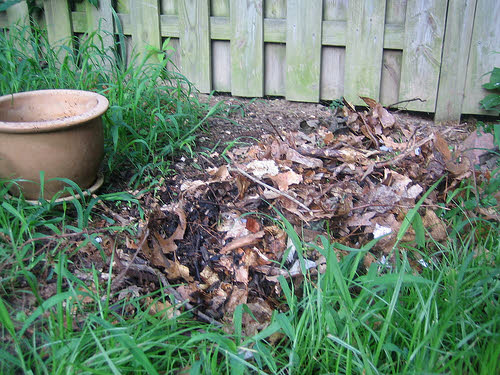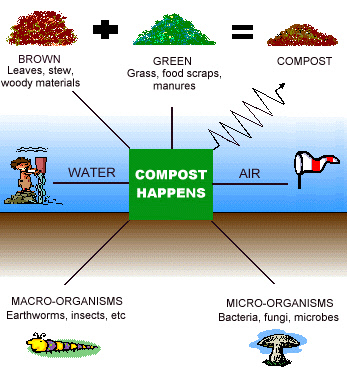After leaves fall from trees, they gradually turn into a soft black substance sometimes referred to as ‘humus.’ This process doesn’t require any help from us. Everything that was once living naturally decomposes and returns to the earth. Composting is based on this natural process and begins with thousand of microorganisms already present in the soil. These microbes feed on the organic waste and generate heat when doing so. When the temperature is warmer, other types of ‘decomposer’ organisms – bacteria, fungi and insects – move in and enjoy the buffet of free food in a composting pile.
Composting is the most natural way to fertilize your garden by using nature to help nature and dispose of food waste.
Building Your Own Compost Pile
The actual design of your compost pile can vary. There are premade bins available at the hardware store, or you can make a homemade composter with as little as a hole dug in the ground. However, what you fill the pile with matters more than what you make the container out of.
Items needed:
- Green material – grass, leaves, coffee grounds, egg shells, peelings, manure (not dog or cat) etc. Anything high in nitrogen
- Brown material – paper, saw dust, twigs, straw etc. Anything high in carbon
- Shovel, pitch fork
- Lawn Mower *
- Whipper Snipper (weed whacker)*
- Gloves
- Patience
*Optional
Directions:
- Select a space in the yard for the compost pile.
- Shred the green and brown materials as much as possible. The smaller the pieces the better for composting. Tip: Use the lawn mower and go over your pile of leaves or put the leaves in a garbage can and use the whipper snipper to make your own compost blender.
- The compost pile should be 3 feet in each direction – height, width, length. Smaller piles won’t retain heat as effectively and won’t kill any harmful bacteria present. If you only compost safe items and keep pets and vermin out, there’s no cause for concern – but if you use the compost for your veggie garden, make sure you wash everything thoroughly.
- Layer together 6 inches of the browns and 6 inches of the greens then mix them together. Then alternative the green and brown material layers, add water as required until the pile is at least 3 feet high.
- Keep the pile covered from heavy rain. You want the pile to be as moist as a sponge and wait patiently for the microbes to start working.
- In a few hours (depending on the outside temperature) heat will be produced – a great indication the microbes are eating the materials and creating compost.
Important Tips:
- Keep the compost pile in the same location for a few years – helps to build your own eco-system of compost-friendly organisms and insects.
- Use equal amounts of green and brown material (Editor’s note: at the very least… a 2:1 ratio of brown to green often works best)
- Regularly turn the heap to aerate it
Composting in Winter
Composting can begin at anytime of the year. The Winter is a great time to start because the composting process should be complete when Spring arrives.
The key to composting in the Winter is to encourage the microbes to get back to work or to start working and create the compost you need. You need to generate heat to get them working again. Items such as coffee grounds, horse manure – if you have a supply available – and molasses (mixed 1 part per 20 parts water and poured on the more absorbent compostable materials) will help to raise the temperature.
Other options to keep the compost temperature up are insulating it with bales of hay and leaves. Also in the Winter you don’t need to mix up or ‘aerate’ the pile.
Composting in Spring
The Spring is a fantastic time for composting. The warmer temperatures are ideal for the microbes to start eating the waste and creating the compost you need. The compost pile will start to really come together and if the temperature stays at above zero for a long period of time (hopefully it will!), you should have usable compost in about 20 – 21 days. When you’re ready to plant your flowers you’ll have natural fertilizer to go with it.
Composting in Summer
Summer gardening is primarily about maintaining what you already planted in the spring. The hot temperatures in the summer can stop the microbes from working effectively so keep the compost pile moist during a dry spell, and keep it out of direct sunlight.
Composting in Fall
As the leaves start to fall off the trees and fall on your lawn you have a great source of food for the microbes. Instead of bagging the leaves and throwing them out, shred them up and put them in the composter. If you have space available, keep a bag of leaves for an extra boost over the winter months when you can add it to the compost pile.
Using Humus
Compost has the odor of freshly turned soil on a forest floor, and once the microbes are finished turning your banana peel to humus it’s ready to be used in your gardens. There might not be such a thing as ‘bad’ compost, but it should be crumbled, dark and soil-like, and none of the original material should be identifiable.
There you go some ideas and tips on how to change your used coffee grounds into free natural fertilizer. Setting up your compost pile doesn’t require a lot of time, energy or money. The key to composting is patience. Let the microbes do the hard work so that you can enjoy the fact you’re helping the environment.
Jeremy enjoys educating people about how to live greener lives. He wrote this post on behalf of EasyApplianceParts, a DIY repair resource and retailer of appliance replacement parts.
Image credit: Torfaen at Wikimedia Commons under a Creative Commons license; kirybabe at flickr under a Creative Commons license


